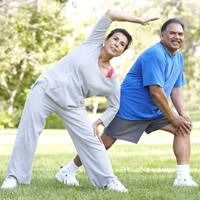The Home Stretch
 |
| Regular Chiropractic Care and Effective Stretching |
| Starting a stretching program is appropriate for most people. As we want to get the most out of our stretching routine, it's important to ensure that our musculoskeletal system is working at peak capacity.
Regular chiropractic care performs these essential services by detecting, analyzing, and correcting spinal misalignments. Left uncorrected, such misalignments cause muscles, ligaments, and joints to become tight and irritated and also cause irritation to spinal nerves. By correcting spinal misalignments, your spinal nerves are free to conduct information properly between your brain and the rest of your body. Your musculoskeletal system is enabled to do its job properly. The result is that regular chiropractic care helps to optimize the functioning of our muscles, bones, and joints, thereby making our stretching and exercise time useful, healthful, and profitable. |
Thanks to effective public health campaigns regarding healthy lifestyle choices, many people have incorporated regular, vigorous exercise, a nutritious diet, and getting sufficient rest in their daily routines. For many people, an additional important component of a healthy lifestyle is regular stretching.
Regular stretching provides numerous benefits, including enhanced flexibility and adaptability of your musculoskeletal system, that is, your bones, muscles, and joints.1 As a result, regular stretching helps improve overall mobility and range of motion. Regular stretching helps reduce injury by improving circulation, bringing increased supplies of oxygen and critical nutrients to the large muscles of your thighs and legs and the small muscles of your back. As a bonus, regular stretching helps to reduce stress. It's clear that stretching activities provide a very big return for a modest investment of time and effort.2,3
In order to derive the greatest benefits from your stretching program, knowledge of stretching "best practices" is essential. First, it's critical to conceive of stretching as a journey rather than a destination. In stretching, we have to give up all our notions of how much we think we should be able to achieve. On any given day, our muscles will be tighter or less tight. On any given day, it will be "harder" or easier to obtain the stretchability of the day before. The best practice is to pay attention to your body, focus on what you're doing, and work with what you have on a particular day. This "centering" approach is in direct contrast to trying to force your muscles to conform to the stretching length you think they should achieve. Using force while stretching will always result in injury. Instead, the activity of stretching calls for a calm, steady, and methodical approach.
What is it that you're doing when you stretch? Primarily, you're using a process of visualization. You're visualizing the particular muscle getting "longer". When you do a stretch for your hamstring muscle group (there are three muscles that comprise this group), you have an image in your mind of the muscles of the back of your thigh and you're "seeing" these muscles lengthening. You're not actually "doing" anything other than performing the activity of the stretch itself. In other words, you're not actively making the hamstrings longer. But you are "seeing" them lengthen in your mind, and the result is an effective stretch, that is, increased length and flexibility of the hamstring group.
Pictures of the quadriceps muscle group (the muscles on the front of your thigh), the hamstring muscle group, the calf muscles (the surface gastrocnemius and the deeper soleus), and your spinal muscle groups will provide great assistance with your visualization process. Such images are widely available on the Internet. Your "Zen-like" process of visualization will make your 10 or 15 minutes of stretching time more effective and may also be applied to various other tasks throughout your day, providing additional ongoing benefits to your health and well being.
1Peck E, et al: The effects of stretching on performance. Cur Sports Med Rep 13(3):179-185, 2014
2Morrin N, Redding E: Acute effects of warm-up stretch protocols on balance, vertical jump height, and range of motion in dancers. J Dance Med Sci 17(1):34-40, 2013
3Avloniti A, et al: The Acute Effects of Static Stretching on Speed and Agility Performance Depend on Stretch Duration and Conditioning Level. J Strength Cond Res 2014 Jun 17 [Epub ahead of print]

